Gold and minerals have long been coveted for their value and potential in the market. With advancements in technology, there are now more ways than ever to unlock the potential of these precious resources. This article will explore the various opportunities and strategies for capitalizing on the market for gold and minerals, and how businesses and investors can maximize their returns by leveraging these valuable assets.
Unlocking the potential of gold and minerals in the market involves various factors such as exploration, extraction, refining, and utilization. This process requires extensive knowledge of geological formations, advanced mining techniques, and efficient processing methods. Additionally, factors such as market demand, pricing trends, and regulatory considerations also play a critical role in fully realizing the potential of gold and minerals in the market. Overall, it involves a comprehensive approach that encompasses technical expertise, market analysis, and strategic decision-making to maximize the value of these resources.
Exploring the World of Gold and Minerals: A Beginner’s Guide

Gold and minerals have long been a source of fascination and intrigue for people around the world. From the glimmering allure of gold to the diverse uses of minerals in various industries, these natural resources play a significant role in our daily lives. Whether it’s through jewelry, electronic devices, or as a commodity for investment, the value of gold and minerals cannot be understated. However, the extraction and utilization of these resources also raise important ethical and environmental concerns that must be addressed. As we continue to delve into the world of gold and minerals, it is essential to understand their impacts and potential for sustainable utilization.
Exploring the World of Gold and Minerals: A Beginner’s Guide is a comprehensive introduction to the world of precious metals and minerals. It covers the basics of geology, mining, and the different types of gold and minerals that can be found around the world. The book also delves into the various uses of gold and minerals in industries such as jewelry, electronics, and medicine. With clear and accessible language, this guide is perfect for anyone who is interested in learning more about these valuable and fascinating natural resources.
The Economic Impact of Gold and Mineral Mining on Local Communities

Gold and mineral mining can have a significant economic impact on local communities. It can create jobs, stimulate growth in local businesses, and contribute to regional economic development. Additionally, mining companies often invest in infrastructure and social programs, such as schools and hospitals, in the areas where they operate, further benefiting local communities. However, there can also be negative impacts, such as environmental degradation and social disruption. It is important for mining companies to work with local stakeholders to mitigate these negative effects and ensure that the economic benefits of mining are shared equitably within the community.
Uncovering the Environmental Effects of Gold and Mineral Extraction

Uncovering the environmental effects of gold and mineral extraction involves conducting comprehensive studies on the impact of mining activities on air and water quality, soil erosion, deforestation, and wildlife habitats. It also entails quantifying the release of toxic substances such as mercury and cyanide into the environment, as well as assessing the long-term consequences on local ecosystems and communities. This research is crucial for developing sustainable mining practices and mitigating the environmental footprint of the industry.
The Surprising Health Benefits of Gold and Minerals

The surprising health benefits of gold and minerals include their potential to boost immune function, improve circulation, and reduce inflammation. Gold has been used in traditional medicine for centuries to treat conditions such as arthritis and other inflammatory disorders. Minerals such as magnesium, calcium, and zinc are essential for maintaining strong bones, healthy skin, and overall wellbeing. Additionally, minerals play a key role in many biochemical processes in the body, including energy production and hormone regulation. Consuming a balanced diet rich in these essential minerals can support overall health and wellness.
Investing in the Future: The Role of Gold and Minerals in the Stock Market
Investing in the Future: The Role of Gold and Minerals in the Stock Market explores how precious metals and minerals contribute to a diversified investment portfolio. Gold, silver, and other mineral commodities have historically served as hedges against inflation and economic uncertainty, making them appealing to investors. Additionally, mining companies that produce these commodities often generate strong returns for shareholders. Understanding the dynamics of the gold and mineral markets is essential for savvy investors looking to capitalize on potential opportunities in the stock market.
The Fascinating History of Gold and Mineral Use in Ancient Civilizations
The use of gold and other minerals in ancient civilizations dates back thousands of years. Gold was highly valued for its rarity and luster, and it was often used for jewelry, religious objects, and as a form of currency. Ancient Egyptians used gold to adorn their pharaohs and build elaborate tombs, such as the famous tomb of Tutankhamun. In ancient Mesopotamia, gold and other minerals were used for a variety of purposes, including ornamentation and trade.
The ancient Greeks and Romans also placed a high value on gold and used it in jewelry, coins, and religious ceremonies. They also used other minerals such as silver, copper, and iron for various purposes, including building construction, tools, and weapons.
In ancient China, gold and other minerals were similarly valued and used for a wide range of purposes, including currency, jewelry, and sacred objects. Chinese miners were skilled at extracting gold from rivers and streams using techniques that are still used today.
Overall, the use of gold and other minerals in ancient civilizations played a significant role in shaping their economies, cultures, and societies, and continues to have a lasting impact on the world today.
Innovations in Technology: How Gold and Minerals are Used in Electronics
See also: the price for gold
Gold and minerals are widely used in the electronics industry for various purposes. Gold is a highly conductive metal that is used in circuitry and electrical contacts in electronic devices. It is also used in the production of microchips, as it is an excellent material for providing reliable electrical connectivity.
Minerals such as tantalum, tungsten, and tin are used in the production of capacitors and resistors in electronic devices. These minerals are essential for creating stable and reliable electronic components.
Additionally, rare earth minerals like neodymium and cerium are used in the production of magnets and batteries in electronic devices. These minerals are crucial for creating energy-efficient and high-performance electronics.
Overall, gold and minerals play a critical role in the manufacture of electronic devices, contributing to their functionality, performance, and reliability. As technology continues to advance, the demand for these materials in the electronics industry is expected to grow.
The Geopolitical Significance of Gold and Minerals in Global Trade
The geopolitical significance of gold and minerals in global trade lies in their role as crucial resources for economic development and national security. Gold has been used as a store of value and a medium of exchange for centuries, shaping the international monetary system and influencing geopolitical dynamics. Minerals, on the other hand, are essential for industrial production, infrastructure development, and technological advancements, making them integral to global supply chains and geopolitical competition.
The control over gold and mineral resources can determine a country’s economic power and global influence, as well as its ability to leverage these resources for strategic gains. Geopolitical tensions often revolve around access to and control of these resources, driving competition, conflicts, and alliances among nations.
Furthermore, the trade and export of gold and minerals can have significant impacts on global geopolitics, as countries seek to secure access to these resources through trade agreements, investment strategies, and diplomatic alliances. Additionally, the extraction and production of gold and minerals can also raise environmental and social concerns, leading to regulatory and geopolitical challenges for resource-rich countries and their trade partners.
Overall, the geopolitical significance of gold and minerals in global trade underscores their importance as strategic commodities that shape international relations, trade patterns, and global power dynamics. Their role in driving economic growth, technological innovation, and geopolitical competition makes them critical considerations for policymakers, businesses, and international stakeholders.
The Ethical Dilemmas Surrounding Gold and Mineral Mining Operations
Gold and mineral mining operations often present a range of ethical dilemmas. One of the most significant concerns is the environmental impact of these operations, including deforestation, water pollution, and habitat destruction. In addition, human rights abuses, such as forced labor and displacement of indigenous communities, are frequently associated with mineral mining. Furthermore, the extraction and trade of gold and minerals are often linked to funding conflicts and perpetuating corruption in some regions. These ethical concerns have led to growing pressure on mining companies to improve their practices and ensure sustainable and responsible operations.
Discovering the Beauty of Gold and Mineral-based Jewelry and Art
Discovering the beauty of gold and mineral-based jewelry and art can be a captivating and enriching experience. Gold has long been valued for its luster and rarity, making it a timeless choice for jewelry and artistic creations. Its malleability allows for intricate designs and detailed craftsmanship.
Mineral-based jewelry and art, such as pieces incorporating gemstones or crystals, offer a diverse range of colors and textures that can enhance any piece. From colorful gemstone rings to sparkling crystal pendants, there is a wide variety of options to explore and appreciate.
Many artists and jewelry designers are drawn to the natural beauty and unique qualities of these materials, incorporating them into their work with creativity and skill. Whether it’s a handcrafted gold ring or a one-of-a-kind mineral-based sculpture, these pieces can be a stunning addition to any collection.
By exploring and appreciating the beauty of gold and mineral-based jewelry and art, you can gain a greater understanding of the craftsmanship and artistry involved in creating these timeless pieces. Whether as a collector, enthusiast, or simply an admirer, there is much to discover and enjoy in the world of gold and mineral-based jewelry and art.
In conclusion, it is evident that the market for gold and minerals holds great potential for growth and development. By unlocking the resources and investing in innovative technology and sustainable practices, we can maximize the value of gold and minerals in the market. The increasing demand for these precious resources presents a promising opportunity for economic prosperity and environmental stewardship. With strategic planning and responsible management, the future of gold and minerals in the market looks bright.
See also
https://www.veracash.com/fr/cours-or
https://www.bdor.fr/cours-or
https://www.gold.fr/







